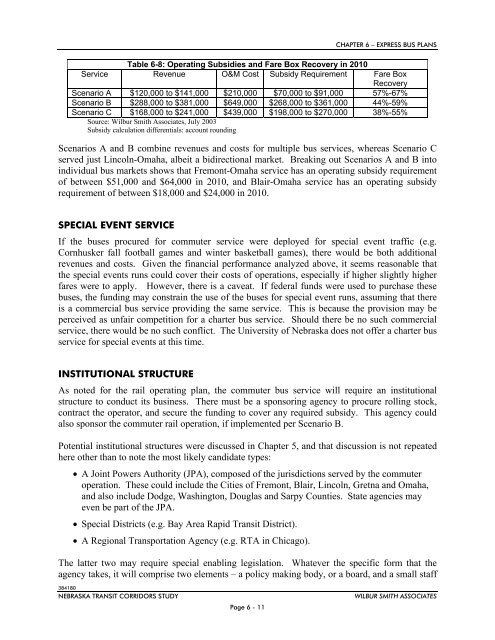NTRAC Final Study - Nebraska Department of Roads - State of ...
NTRAC Final Study - Nebraska Department of Roads - State of ...
NTRAC Final Study - Nebraska Department of Roads - State of ...
Create successful ePaper yourself
Turn your PDF publications into a flip-book with our unique Google optimized e-Paper software.
CHAPTER 6 – EXPRESS BUS PLANS<br />
Table 6-8: Operating Subsidies and Fare Box Recovery in 2010<br />
Service Revenue O&M Cost Subsidy Requirement Fare Box<br />
Recovery<br />
Scenario A $120,000 to $141,000 $210,000 $70,000 to $91,000 57%-67%<br />
Scenario B $288,000 to $381,000 $649,000 $268,000 to $361,000 44%-59%<br />
Scenario C $168,000 to $241,000 $439,000 $198,000 to $270,000 38%-55%<br />
Source: Wilbur Smith Associates, July 2003<br />
Subsidy calculation differentials: account rounding<br />
Scenarios A and B combine revenues and costs for multiple bus services, whereas Scenario C<br />
served just Lincoln-Omaha, albeit a bidirectional market. Breaking out Scenarios A and B into<br />
individual bus markets shows that Fremont-Omaha service has an operating subsidy requirement<br />
<strong>of</strong> between $51,000 and $64,000 in 2010, and Blair-Omaha service has an operating subsidy<br />
requirement <strong>of</strong> between $18,000 and $24,000 in 2010.<br />
SPECIAL EVENT SERVICE<br />
If the buses procured for commuter service were deployed for special event traffic (e.g.<br />
Cornhusker fall football games and winter basketball games), there would be both additional<br />
revenues and costs. Given the financial performance analyzed above, it seems reasonable that<br />
the special events runs could cover their costs <strong>of</strong> operations, especially if higher slightly higher<br />
fares were to apply. However, there is a caveat. If federal funds were used to purchase these<br />
buses, the funding may constrain the use <strong>of</strong> the buses for special event runs, assuming that there<br />
is a commercial bus service providing the same service. This is because the provision may be<br />
perceived as unfair competition for a charter bus service. Should there be no such commercial<br />
service, there would be no such conflict. The University <strong>of</strong> <strong>Nebraska</strong> does not <strong>of</strong>fer a charter bus<br />
service for special events at this time.<br />
INSTITUTIONAL STRUCTURE<br />
As noted for the rail operating plan, the commuter bus service will require an institutional<br />
structure to conduct its business. There must be a sponsoring agency to procure rolling stock,<br />
contract the operator, and secure the funding to cover any required subsidy. This agency could<br />
also sponsor the commuter rail operation, if implemented per Scenario B.<br />
Potential institutional structures were discussed in Chapter 5, and that discussion is not repeated<br />
here other than to note the most likely candidate types:<br />
A Joint Powers Authority (JPA), composed <strong>of</strong> the jurisdictions served by the commuter<br />
operation. These could include the Cities <strong>of</strong> Fremont, Blair, Lincoln, Gretna and Omaha,<br />
and also include Dodge, Washington, Douglas and Sarpy Counties. <strong>State</strong> agencies may<br />
even be part <strong>of</strong> the JPA.<br />
Special Districts (e.g. Bay Area Rapid Transit District).<br />
A Regional Transportation Agency (e.g. RTA in Chicago).<br />
The latter two may require special enabling legislation. Whatever the specific form that the<br />
agency takes, it will comprise two elements – a policy making body, or a board, and a small staff<br />
384180<br />
NEBRASKA TRANSIT CORRIDORS STUDY<br />
Page 6 - 11<br />
WILBUR SMITH ASSOCIATES

















